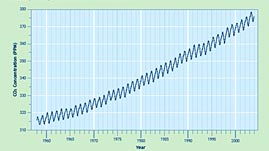Teachers' Domain - Digital Media for the Classroom and Professional Development
User: Preview

Source: Carbon Dioxide Information Analysis Center, Oak Ridge National Laboratory, U.S. Department of Energy
The current practice of burning fossil fuels to provide energy for transportation, heating, cooking, electricity, and manufacturing adds carbon dioxide to the atmosphere more rapidly than it is removed. The result, most climate experts agree, is an intensification of the greenhouse effect and an increase in global temperatures. This document, adapted from the Carbon Dioxide Information Analysis Center, plots an increase in atmospheric CO2 concentrations since 1958.
Temperature data from a variety of sources show that average global temperatures have risen slightly more than one degree Fahrenheit in the past century. What may sound like a small change to us actually suggests an alarming trend to many climate experts. After all, ice ages and the warm interglacial periods between them are marked by changes of just four or five degrees, which can have dramatic effects on ecosystems and landscapes. A warming trend on top of the current interglacial period could have devastating consequences for human societies.
Most scientists agree that the recent increase in global temperatures results, at least in part, from human activities rather than changes in Earth's orbit or some other natural cause. Data used to support this conclusion show a rise in concentrations of atmospheric greenhouse gases, such as carbon dioxide (CO2). This increase correlates roughly with rising global temperatures and suggests a powerful mechanism for the warming trend.
Climate experts see a link between greenhouse gas concentrations and global temperatures because these gases are responsible for keeping Earth warm in the first place. Carbon dioxide, water vapor, methane, nitrous oxide, and a few other compounds readily absorb infrared radiation coming from Earth's surface. They then vibrate and ultimately either re-emit the radiation they had absorbed or pass the energy to nearby molecules. This absorption-emission-absorption cycle in the lower atmosphere keeps heat near Earth's surface, effectively insulating the planet from the cold of space.
In the proper balance, greenhouse gases make life on Earth possible. However, any increase in the concentration of these gases poses the risk of altering the natural balance and dramatically changing global temperatures.
The most complete and accurate set of data on atmospheric CO2 concentrations comes from the Mauna Loa Observatory on the island of Hawaiʻi. Every hour for nearly half a century, scientists have collected air samples from above a barren lava field on the slopes of Earth's largest volcano. The remote location of this site minimizes local disturbances to measurements due to the activity of humans, other animals, and plants.
Analysis of the Mauna Loa record shows that the mean annual concentration of CO2 has increased 19.4 percent in 45 years, from 315.98 parts per million by volume (ppmv) in 1959 to 377.38 ppmv in 2004. During that time, the average annual increase was 1.4 ppmv, with the largest annual growth rate of 2.87 ppmv occurring between 1997 and 1998.
 Loading Standards
Loading Standards Teachers' Domain is proud to be a Pathways portal to the National Science Digital Library.
Teachers' Domain is proud to be a Pathways portal to the National Science Digital Library.
